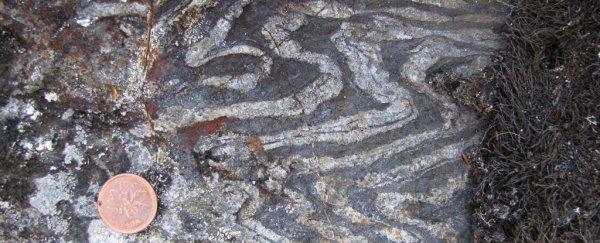All life on Earth likely emerged from one spark in Earth's early history. Some time later, it diversified, branching off into lineages that helped it survive.
Exactly when these moments occurred has been a point of contention in the scientific community, but new research suggests both steps may have taken place earlier than we previously thought.
The study, led by University College London researchers builds on evidence of diverse microbial life inside a fist-sized piece of rock from Quebec in Canada, dated to around 3.75 billion to 4.28 billion years.
In 2017, the researchers who discovered it speculated that structures in the rock – tiny filaments, knobs, and tubes – had been left by ancient bacteria.
But not everyone was convinced that these structures – which would push the date for the first signs of life on Earth back by at least 300 million years – were biological in origin.
 The filaments seen here are the stem-like structures indicating oldest known fossils.(D. Papineau)
The filaments seen here are the stem-like structures indicating oldest known fossils.(D. Papineau)
However, after further extensive analysis of the rock, the team discovered an even larger and more complex structure than those which were previously identified. Within the rock was a stem-like structure with parallel branches on one side that are nearly a centimeter long, as well as hundreds of distorted spheres, or ellipsoids, alongside the tubes and filaments.
"This means life could have begun as little as 300 million years after Earth formed. In geological terms, this is quick – about one spin of the Sun around the galaxy," says lead author of the study, geochemist Dominic Papineau from UCL.
The key question for Papineau and his colleagues was whether it was possible for these structures to have formed through chemical reactions not related to living things.
According to the paper, some of the smaller structures could have conceivably been the product of abiotic reactions, however, the newly identified 'tree-like' stem is most likely biological in origin, as no structure like it, created through chemical reactions alone, has been found before.
In addition to the structures, researchers identified mineralized chemicals in the rock that could have been byproducts of different types of metabolic processes.
The chemicals are consistent with energy-extraction processes in the bacteria that would have involved iron and sulfur; depending on the interpretation of chemical signatures, there could even be hints of a version of photosynthesis.
This finding points to the possibility that the early Earth – only 300 million years after its formation – was inhabited by an array of microbial life.
The rock was analyzed through a combination of optical observations through Raman microscopes (which use light scattering to determine chemical structures), and digitally recreating sections of the rock with a supercomputer that processed thousands of images from two high-resolution imaging techniques.
The piece of rock in question was collected by Papineau in 2008 from Quebec's Nuvvuagittuq Supracrustal Belt (NSB), which was once a part of the seafloor. The NSB contains some of the oldest sedimentary rocks known on Earth. The fossil-laden rock was also analyzed for levels of rare Earth elements, with researchers finding it did indeed have the same levels as other ancient rock specimens, confirming it was as old as the surrounding volcanic rocks.
 Bright red iron and silica-rich rock which contains tubular and filamentous microfossils. (D. Papineau)
Bright red iron and silica-rich rock which contains tubular and filamentous microfossils. (D. Papineau)
Prior to this discovery, the earliest fossil evidence of life was found in Western Australia, which dates back 3.46 billion years. However, similar contention exists around whether these fossils were biological in origin.
Perhaps the most exciting implications from this discovery are what it means for the potential distribution of life in the Universe. If life was able to develop and evolve in the harsh conditions of the very early Earth, then it may be more common throughout the cosmos than we think.
"This discovery implies that only a few hundred million years are needed for life to evolve to an organized level on a primordial habitable planet," state the authors of the paper.
"We therefore conclude that such microbial ecosystems could exist on other planetary surfaces where liquid water interacted with volcanic rocks, and that these oldest microfossils and dubiofossils reported here from the NSB suggest that extraterrestrial life may be more widespread than previously thought."
The study was published in the journal Science Advances.
